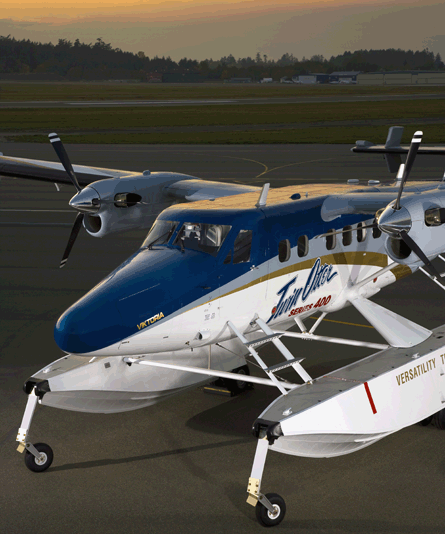Canada's Viking Air is considering using E-coat in the production process for its new DHC-6 Twin Otter Series 400 to boost the corrosion-resistance capabilities of the turbine twin and attract carriers that operate the aircraft as floatplanes in the harshest of conditions - salt water.
Developed for the automotive industry, E-coat is a hybrid between electrostatic spray and powder coating. Should Viking opt for an E-coat process, it will become the first aircraft manufacturer to do so, says Viking vice-president of business development Rob Mauracher.
"We're testing samples to see how they hold up in a salt water regime and that's part of our decision making for whether to go with it in the new aircraft," he says.
Some 600 aged Twin Otters are in operation all over the world, about one-third operating in highly corrosive salt water environments.
Viking took this into consideration when it resurrected production of the 19-seat de Havilland Canada aircraft in 2007. Among more than 200 changes being made to the design is the inclusion of more drains and the use of different corrosion prevention materials. "These -400s all have new corrosion prevention compounds. It's in the primer, the chemical edging, how we put the parts together, and how many coats are used," says Mauracher.
The Pratt & Whitney Canada PT6A-34-powered twin turbine also boasts a new Honeywell Primus Apex integrated avionics suite.
 |
|---|
© Viking Air |
"We've taken away a myriad of connections where wiring could cause corrosion. All of those systems that have caused maintenance issues in the past [on aged Twin Otters] have been removed because in a corrosive environment, every one of those wires could become corroded and cause a maintenance event."
The Viking executive says "all those things that weren't done to the best standard in the past are now being done for the Series 400".
He says that if a seaplane operator takes a new -400, and follows a strict regime of fresh water wash, the aircraft will hold up well. A three-year warranty is attached to the aircraft.
But there are other differences in the new -400 compared with older Twin Otters, including "on the maintenance side, on reliability, and on all the things that enhance the flying experience", says Mauracher.
Whether these changes will be enough to convince aged Twin Otter stalwart Seaborne Airlines to acquire the new -400 remains to be seen. Seaborne operates six Twin Otters with an average age of 30 years. Four of these are deployed on high-frequency seaplane service between St Croix and St Thomas.
"The Twin Otter is very versatile. You couldn't come up with any other aircraft for this type of environment," says Seaborne director of operations Wayne D'Amico.
Nonetheless, as Seaborne's seaplanes operate in salt water, they must undergo major overhaul every three years at a cost of about $1.5 million each, which is about equivalent to the bluebook value of the actual aircraft.
Seaborne believes it is better served operating older models. Four new aircraft would cost "about $15 million", says president and chief executive Omer ErSelcuk. "The [new] aircraft get used up faster than you can get money out of them. Once an airplane starts being exposed to salt water, the clock starts ticking."
Even with newly acquired aircraft, a seaplane operator must find a good overhaul shop. ErSelcuk refers to the process of taking the Twin Otter apart - tearing it "down to nothing" and building it back up as the "Super D check". Seaborne contracts overhaul facilities on the US mainland for the work.
Other carriers that operate in salt water have been convinced to acquire the -400. One of the largest seaplane operators in the world, Maldivian Air, has ordered two, says Mauracher. He says Viking's backlog totals about 40, which takes the company into 2011 in terms of production. The airframer is on track to deliver its first -400 to Swiss charter operator Zimex Aviation in August.
Source: Flight International























